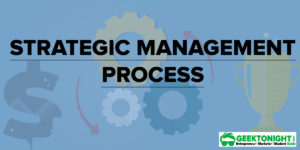Information and Control System
Information and controls are to be an integral part of any organization’s functional-level strategies. The information system of the organization should be up to date as it should have complete knowledge about the market trends and its close competitors.
With a strong and efficient information system an organization and formulate its strategies or can alter the strategies if any time need arises. A bad information system (internal or external) can be a great hurdle in achieving success or the target of the organization. Controls consist of all the measures taken by the organization for:
Table of Content
- Protecting its resources against waste, fraud, and inefficiency;
- Ensuring accuracy and reliability in accounting and operating data;
- Securing compliance with the policies of the organization; and
- Evaluating the level of performance in all organizational units of the organization. Controls are simply good business practices.
Responsibility
Everyone within the organization has some role in control. The roles vary depending on the level of responsibility and the nature of involvement by the individual. The Board of President and senior executives establish the presence of integrity, ethics, competence, and a positive control environment. The department heads have oversight responsibility for controls within their units.
Managers and supervisory personnel are responsible for executing control policies and procedures at the detail level within their specific unit. Each individual within a unit is to be cognizant of proper internal control procedures associated with their specific job responsibilities.
The internal audit role is to examine the adequacy and effectiveness of the company’s internal controls and make recommendations where control improvements are needed. Since internal auditing is to remain independent and objective, the internal audit office does not have the primary responsibility for establishing or maintaining internal controls.
Elements of Internal Control
Internal control systems operate at different levels of effectiveness. Determining whether a particular internal control system is effective is a judgment resulting from an assessment of whether the five components – Control Environment, Risk Assessment, Control Activities, Information, and Communication and Monitoring – are present and functioning. Effective controls provide reasonable assurance regarding the accomplishment of established objectives.
Control Environment
The control environment, as established by the organization’s administration, sets the tone of the organization and influences the control consciousness of its people. Managers of each department, area or activity establish a local control environment. This is the foundation for all other components of internal control, providing discipline and structure. Control environment factors include:
- Integrity and ethical values;
- The commitment to competence;
- Leadership philosophy and operating style;
- The way management assigns authority and responsibility and organizes and develops its people;
- Policies and procedures.
Risk Assessment
Every entity faces a variety of risks from external and internal sources that must be assessed. A precondition to risk assessment is the establishment of objectives, linked at different levels and internally consistent.
Risk assessment is the identification and analysis of relevant risks to the achievement of the objectives, forming a basis for determining how the risks should be managed. Because economics, regulatory and operating conditions will continue to change, mechanisms are needed to identify and deal with the special risks associated with change.
Objectives must be established before Managers can identify and take necessary steps to manage risks. Operations objectives relate to the effectiveness and efficiency of the operations, including performance and financial goals and safeguarding resources against loss.
Financial reporting objectives pertain to the preparation of reliable published financial statements, including the prevention of fraudulent financial reporting. Compliance objectives pertain to laws and regulations which establish minimum standards of behavior.
The process of identifying and analyzing risk is ongoing and is a critical component of an effective internal control system. Attention must be focused on risks at all levels and necessary actions must be taken to manage. Risks can pertain to internal and external factors. After risks have been identified they must be evaluated.
Managing change requires a constant assessment of risk and the impact on internal controls. Economic, industry, and regulatory environments change and entities’ activities evolve. Mechanisms are needed to identify and react to changing conditions.
Control Activities
Control activities are the policies and procedures that help ensure management directives are carried out. They help ensure that necessary actions are taken to address risks to the achievement of the entity’s objectives. Control activities occur throughout the organization, at all levels, and in all functions.
They include a range of activities as diverse as approvals, authorizations, verifications, reconciliations, reviews of operating performance, security of assets, and segregation of duties. Control activities usually involve two elements: a policy establishing what should be done and procedures to effect the policy. All policies must be implemented thoughtfully, conscientiously, and consistently.
Information and Communication
Pertinent information must be identified, captured, and communicated in a form and time frame that enables people to carry out their responsibilities. Effective communication must occur in a broad sense, flowing down, across, and up the organization.
All personnel must receive a clear message from top management that control responsibilities must be taken seriously. They must understand their role in the internal control system, as well as how individual activities relate to the work of others. They must have a means of communicating significant information upstream.
Monitoring
Control systems need to be monitored – a process that assesses the quality of the system’s performance over time. Ongoing monitoring occurs in the ordinary course of operations and includes regular management and supervisory activities, and other actions personnel take in performing their duties that assess the quality of internal control system performance.
The scope and frequency of separate evaluations depend primarily on an assessment of risks and the effectiveness of ongoing monitoring procedures. Internal control deficiencies should be reported upstream, with serious matters reported immediately to top administration and governing boards.
Control systems change over time. The way controls are applied may evolve. Once effective procedures can become less effective due to the arrival of new personnel, varying effectiveness of training and supervision, time and resources constraints, or additional pressures. Furthermore, the circumstances for which the internal control system was originally designed also may change. Because of changing conditions, management needs to determine whether the internal control system continues to be relevant and able to address new risks.
Components of the Control Activity
- Internal controls rely on the principle of checks and balances in the workplace.
- Personnel needs to be competent and trustworthy, with clearly established lines of authority and responsibility documented in written job descriptions and procedures manuals. Organizational charts provide a visual presentation of lines of authority and periodic updates of job descriptions ensure that employees are aware of the duties they are expected to perform.
- Authorization procedures need to include a thorough review of supporting information to verify the propriety and validity of transactions. Approval authority is to be commensurate with the nature and significance of the transactions and in compliance with the organization’s policy.
- Segregation of duties reduces the likelihood of errors and irregularities. An individual is not to have responsibility for more than one of the three transaction components: authorization, custody, and record keeping. When the work of one employee is checked by another, and when the responsibility for the custody of assets is separate from the responsibility for maintaining the records relating to those assets, there is appropriate segregation of duties. This helps detect errors promptly and deter improper activities; at the same time, it should be devised to prompt operational efficiency and allow for effective communications.
- Physical restrictions are the most important type of protective measures for safeguarding company assets, processes, and data.
- Documentation and record retention are to provide reasonable assurance that all information and transactions of value are accurately recorded and retained. Records are to be maintained and controlled by the established retention period and properly disposed of by established procedures.
- Monitoring operations is essential to verify that controls are operating properly. Reconciliations, confirmations, and exception reports can provide this type of information.
Business Ethics
(Click on Topic to Read)
- What is Ethics?
- What is Business Ethics?
- Values, Norms, Beliefs and Standards in Business Ethics
- Indian Ethos in Management
- Ethical Issues in Marketing
- Ethical Issues in HRM
- Ethical Issues in IT
- Ethical Issues in Production and Operations Management
- Ethical Issues in Finance and Accounting
- What is Corporate Governance?
- What is Ownership Concentration?
- What is Ownership Composition?
- Types of Companies in India
- Internal Corporate Governance
- External Corporate Governance
- Corporate Governance in India
- What is Enterprise Risk Management (ERM)?
- What is Assessment of Risk?
- What is Risk Register?
- Risk Management Committee
Corporate social responsibility (CSR)
Lean Six Sigma
- Project Decomposition in Six Sigma
- Critical to Quality (CTQ) Six Sigma
- Process Mapping Six Sigma
- Flowchart and SIPOC
- Gage Repeatability and Reproducibility
- Statistical Diagram
- Lean Techniques for Optimisation Flow
- Failure Modes and Effects Analysis (FMEA)
- What is Process Audits?
- Six Sigma Implementation at Ford
- IBM Uses Six Sigma to Drive Behaviour Change
Research Methodology
Management
Operations Research
Operation Management
- What is Strategy?
- What is Operations Strategy?
- Operations Competitive Dimensions
- Operations Strategy Formulation Process
- What is Strategic Fit?
- Strategic Design Process
- Focused Operations Strategy
- Corporate Level Strategy
- Expansion Strategies
- Stability Strategies
- Retrenchment Strategies
- Competitive Advantage
- Strategic Choice and Strategic Alternatives
- What is Production Process?
- What is Process Technology?
- What is Process Improvement?
- Strategic Capacity Management
- Production and Logistics Strategy
- Taxonomy of Supply Chain Strategies
- Factors Considered in Supply Chain Planning
- Operational and Strategic Issues in Global Logistics
- Logistics Outsourcing Strategy
- What is Supply Chain Mapping?
- Supply Chain Process Restructuring
- Points of Differentiation
- Re-engineering Improvement in SCM
- What is Supply Chain Drivers?
- Supply Chain Operations Reference (SCOR) Model
- Customer Service and Cost Trade Off
- Internal and External Performance Measures
- Linking Supply Chain and Business Performance
- Netflix’s Niche Focused Strategy
- Disney and Pixar Merger
- Process Planning at Mcdonald’s
Service Operations Management
Procurement Management
- What is Procurement Management?
- Procurement Negotiation
- Types of Requisition
- RFX in Procurement
- What is Purchasing Cycle?
- Vendor Managed Inventory
- Internal Conflict During Purchasing Operation
- Spend Analysis in Procurement
- Sourcing in Procurement
- Supplier Evaluation and Selection in Procurement
- Blacklisting of Suppliers in Procurement
- Total Cost of Ownership in Procurement
- Incoterms in Procurement
- Documents Used in International Procurement
- Transportation and Logistics Strategy
- What is Capital Equipment?
- Procurement Process of Capital Equipment
- Acquisition of Technology in Procurement
- What is E-Procurement?
- E-marketplace and Online Catalogues
- Fixed Price and Cost Reimbursement Contracts
- Contract Cancellation in Procurement
- Ethics in Procurement
- Legal Aspects of Procurement
- Global Sourcing in Procurement
- Intermediaries and Countertrade in Procurement
Strategic Management
- What is Strategic Management?
- What is Value Chain Analysis?
- Mission Statement
- Business Level Strategy
- What is SWOT Analysis?
- What is Competitive Advantage?
- What is Vision?
- What is Ansoff Matrix?
- Prahalad and Gary Hammel
- Strategic Management In Global Environment
- Competitor Analysis Framework
- Competitive Rivalry Analysis
- Competitive Dynamics
- What is Competitive Rivalry?
- Five Competitive Forces That Shape Strategy
- What is PESTLE Analysis?
- Fragmentation and Consolidation Of Industries
- What is Technology Life Cycle?
- What is Diversification Strategy?
- What is Corporate Restructuring Strategy?
- Resources and Capabilities of Organization
- Role of Leaders In Functional-Level Strategic Management
- Functional Structure In Functional Level Strategy Formulation
- Information And Control System
- What is Strategy Gap Analysis?
- Issues In Strategy Implementation
- Matrix Organizational Structure
- What is Strategic Management Process?
Supply Chain





